The Great Battle of Kursk: a defensive operation by the troops of the Voronezh Front. Part of 3
On 9.30 6 July, the strike group of the 48 tank corps went on the offensive. Around noon, the divisions of the 11 Tank Division and the Great Germany Tank Grenadier Division went to the rear of the 67 Division of Baksov. In 12.00, Chistyakov ordered the three surrounding regiments to retreat. But it was too late. By evening, the German tanks reached the Dmitrievka area, the 199 and 201-th Guards Rifle Regiments of the 67-th Guards Division and the 153-th Guards Rifle Regiment of the 52-th Guards Rifle Division were surrounded. The “boiler” was cleared by units of the 167 Infantry Division. By July 8, part of the units of the Guard regiments was able to break into the disposition of the Soviet troops.
The 48 tank corps entered the second Soviet army frontier. By the time the German troops reached Dubrov, the main forces of the German tank corps had entered the defense zone of the 3 Mechanized Corps under the command of Semen Krivoshein. The mechanized corps consisted of: 1-I, 3-I, 10-I mechanized, 1-I Guards Tank, 49-I tank brigades, 265-th mortar, 35-nd anti-tank artillery regiments and other units. 6 July 1943, the body of the hull was 222 combat-ready tank. The 5 Guards Tank Corps 1 Guards Brigade commanded by Guards Colonel Vladimir Gorelov and a part of the 49 Tank Brigade fought with the advancing German 5 Tank Division of the Leybshtandart SS division of July 16, due to the encirclement of the units. villages Yakovlevo. The fight continued on July 1. Tankers-guardsmen beat on German armored vehicles from ambushes. As a result of July 6, Krivoshein could use only three mechbrigade tanks - 6 vehicles, and several tanks from the 48 separate armored battalion and the rest of the 113 Guards Tank Brigade - against the troops of the 34 tank corps.
The German command wanted to pierce the corridor before the darkness in the second line of the Soviet defense, and began attacking the positions of the 3-th Mechanized Corps. To break into the Soviet positions, the 39 tank regiment "Panther" and the tank regiment of "Great Germany" were united into a single fist. The Germans introduced into the battle large masses of tanks. However, in the evening of July 6, the defense of the 3 th mechanized corps failed to crack.
The 48 Tank Corps 6 July acted more successfully than the July 5. But he suffered serious losses, which seriously reduced his shock capabilities. In particular, while the 4 July tank regiment of the Great Germany division had 112 combat-ready tanks, including the 14 Tiger heavy tanks, by the end of the day the 6 July lost the 59 machines, including the Tigers 12. The 10 Tank Brigade in the morning of July 6 had a Panther 160, by the end of the day only 40 machines remained in the ranks.
Top shot - Marines of the Das Reich Division help pull out the stuck Tiger. Medium shot - Tankmen 5 th Guards. tank army is preparing a tank for battle. The bottom shot is a StuG 40 Ausf G assault gun, shot down by Captain Vinogradov. Source: Maxim Kolomiets, Mikhail Svirin. With the participation of O. Baronov, D. Nedogonov KURSKAYA ARC 5 July - 23 August 1943 (http://lib.rus.ec/b/224976/read).
July 7
In the evening, 6 on July 4 of the Vatutin Commander issued an order by the forces of the Katukov’s 1 tank army and the remnants of the Kravchenko’s 5 Guards Tank Corps to eliminate the enemy’s breakthrough in the area of Luchkov. Mikhail Katukov decided to launch a counterattack with the forces of five tank brigades of the 3 th mechanized corps and the 31 th tank corps from the north and north-east. The 31 tank corps under the command of Dmitry Cherniyenko included 100, 237, and 242 tank brigades. 4 July its composition was 208 tanks T-34 and T-70.
In turn, the commander of the 4 Tank Army Goth sent troops the order No. 3, which defined the goals and tasks for two days. The 2 corps of the SS and the 48 corps of the tank corps were to destroy the main obstacle on the way to Kursk and Oboyan - the forces of the 1 corps and the 6 guards armies. July 8 corps were supposed to destroy the threat in front of their flanks. Soviet tank units were supposed to be surrounded and destroyed in the region of Sukho-Solotino, Rylsky, Pokrovka, Yakovlevo, Syrtsevo. July 7 troops had to prepare for the attack and improve the starting position. The 48 tank corps was to carry out especially serious work. He was supposed to go deeper into the center of the defense of the Soviet troops along the Oboyan highway. On the left flank to force the river Foam. The 2 th SS tank corps 6 July achieved greater success, so 7 July reduced the intensity of hostilities. To continue the onset of the 2 tank corps, the SS required a significant improvement at the junction with the 48 corps. The Hausser 7 corps of July repelled the attacks of the 3 th mechanized and 31 th tank corps on the left flank and tried to push back the troops of the 2 th Guards Tank Corps - on the right.
The main battles were in the offensive zone of the 48 tank corps. On the morning of July 7, German troops attacked again. Katukov's army occupied the line of defense along the Pena River. The left flank was reinforced by the Cherniyenko 31 tank corps, in the center was the Krivoshein 3 mechanized corps, the Getman 6 tank corps was on the right flank. Here the defenses were kept remnants of 90 and 67 of the Guards Rifle Divisions.
German troops advanced on the positions of the 3rd mechanized and 31st tank corps. The main blow was directed at the 3rd mechanized brigade under the command of Colonel Amazasp Babajanyan. The strike group included armored vehicles of the 11th Panzer Division, the Great Germany Division and the Panther Brigade. Attacks of tank units were traditionally preceded by powerful aviation blows of the 8th air corps. The Germans were able to overcome the engineering structures and after several hours of battle broke through the orders of the 3rd mechanized brigade. Of the 30 tanks of the brigade, only 10 T-34s survived. In the evening, during the counterattack, another 4 tanks were lost. Having wedged 3-4 km into the defensive positions of the 3rd mechanized corps, German troops continued to develop an offensive to the north and at the same time tried to reach the rear of the 1st and 10th mechanized brigades of the Soviet corps on their flanks.
After it turned out the direction of the main attack of the German troops. Katukov was able to attract parts from unattached areas. The 112 tank brigade was withdrawn from the Hetman’s corps and advanced in the direction of movement of the German wedge. In 15.00, the brigade entered the battle and led it until dark. Having lost 20 tanks, the 112 Brigade restrained the movement to the north of the Great Germany division. The movement of the 11 Tank Division along the Oboyan Highway to the north was suspended by means of reserves directed by the front command - the 38-I tank brigade of Colonel M. Z. Kiselev (180 tanks) and two anti-tank divisions armed with 70-mm zenith units arrived from the 85 Army. tools. Overcome the resistance of the arriving units of the Germans on the move could not.
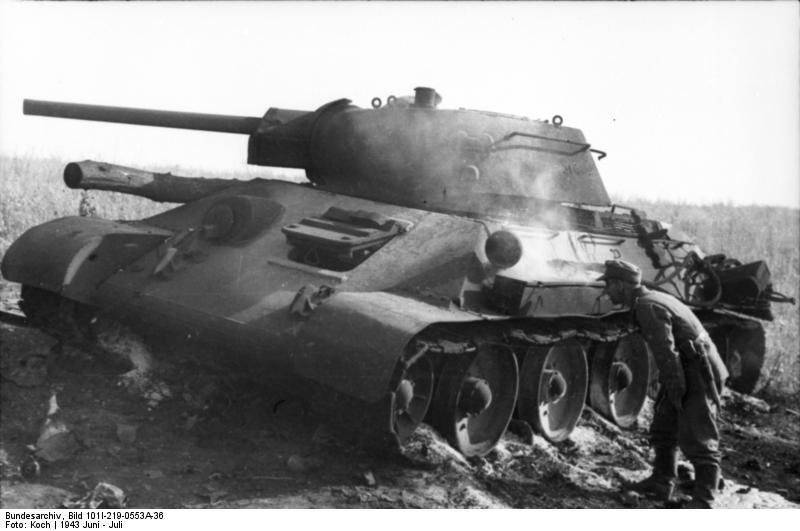
A German soldier examines a downed Soviet tank T-34.
Thus, on July 7, the 48 tank corps crushed the defenses of two mechanized brigades of the 3 mechanized corps, one regiment of the 90 Guards rifle division, and advanced by 6 km. But the Germans could not completely break the defense on the second army line of defense. 6-th Guards Army Chistyakov lost most of the 51-th, 52-th and 67-th Guards Rifle Divisions. 90-I Guards Rifle Division was significantly bloodless. 5-th Guards Tank Corps lost most of the tanks, their number was reduced to the composition of only one full-fledged brigade. Artillery and anti-tank units also suffered heavy losses. However, the 4-I tank army of Goth was unable to achieve decisive success with access to the operating room, and the number of tanks in the shock connections was seriously reduced. By the morning of the fourth day of the battle, the “Great Germany” division of more than 300 tanks that were in the compound at the beginning of the battle had only 80 machines. The SS tank corps, which July 4 totaled 578 tanks and ACS, in the morning of July 8 had 306 combat-ready units.
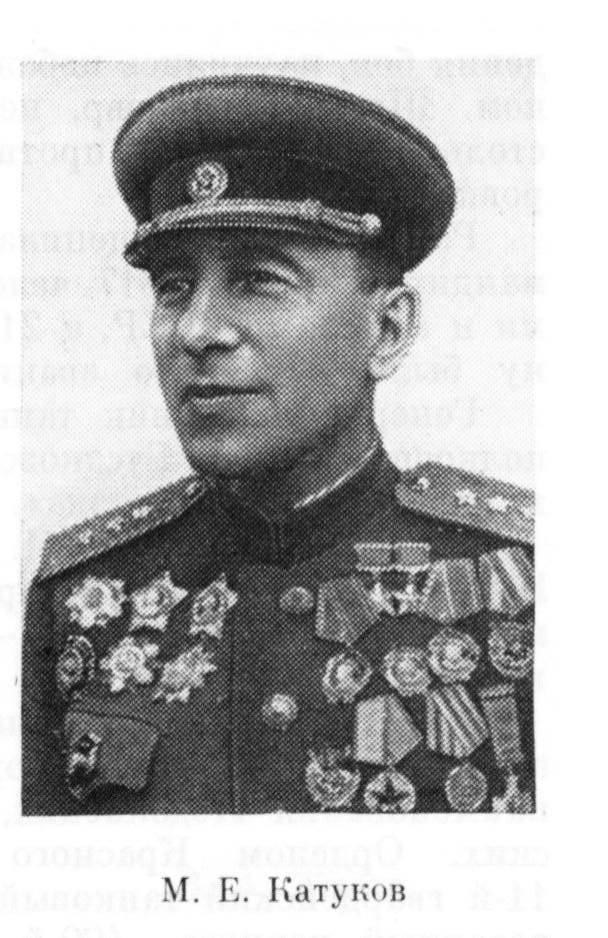
July 8
On the 4 Day of the Kursk Battle, the Voronezh Front began to receive mobile units from the composition of other fronts. The profits of the 10 Tank Corps of Vasily Burkov from the Steppe Front (the Steppe District - before July 9), the 2 Tank Corps of Alexey Popov from the South-Western Front. The arrival of new tank formations prompted the VF command to prepare a new counterblow. They also wanted to attract parts of the 2 and 5 Guards Tank Corps and the 6 Tank Corps from Katukov’s army. However, following the results of the July 7 battles, it became clear that the 1-I tank army could not participate in a counterstrike. In total, 8 July was supposed to take part around 530 tanks and 20 SAU. The tank corps were supposed to inflict a series of strikes on the right flank of the 2 SS tank corps. Almost all the tank corps that were supposed to take part in the counterstrike had their own problems. 5-th Guards Tank Corps, after the oncoming battle and the environment, lost most of the tanks. The remaining were consolidated into two brigades (76 machines). The 2 Guards Tank Corps was separated from the enemy’s position by a river, which reduced its ability to maneuver. The 2 tank corps was moving under its own power from the Urazovo area. His motorized infantry was moving under its own power, lagging behind the tank formations, which reduced the combat capabilities of the corps.
Simultaneously with the preparation of the counterstrike, there was a significant reinforcement of Katukov’s 1 Tank Army. They from the 38 and 40 army were transferred to: 309-th rifle division, 86-th tank brigade (64 tank), 9-th anti-aircraft division, 36-th Guards mortar regiment, three fighter-anti-tank regiment regiments, three fighter-anti-tank regiments, three fighter-anti-tank regiment regiments, three fighter-anti-tank regiment regiments, three fighter-anti-tank regiment regiments, three fighter-anti-tank regiments, three fighter-anti-tank regiment regiments, three fighter-anti-tank regiment, 76-th tank squadron, 38 anti-tank division, 203 anti-tank division, 21-th Command armed XNUMX-mm guns. In addition, a separate heavy tank regiment (XNUMX KV) was transferred to the reserve of the Katukov army from the XNUMX army.
The German command decided on July 8 to continue the offensive, which was to lead to the encirclement of units of the 1 tank and 6 guards armies. The 48 Corps was attacked by the Great Germany Tank Grenadier Division, the 11 Panzer Division was on the defensive. The SS corps formed two strike groups from the Reich and Leibstandart divisions. On the morning of July 8, SS units hit Cherniyenko on the positions of the 31 tank corps. A powerful blow fell on the hull, which he could not stand. By midday, the SS broke through to Kochetovka, where the command post of the 6 Guards Army was. The situation was critical, but in the evening the shock groups 1 and 2 of the SS Panzer Divisions received orders to withdraw, leaving part of the territory seized during the day, and the plan to link the 8 of the 2 corps with the 48 tank corps in July was thwarted. The withdrawal of the SS troops was connected with the counter-attack of the Soviet tank corps.
The morning attacks of 2 and 5 of the Guards Tank Corps, weakened by previous battles, could not stop the attack of the Hausser corps. They were restrained by air strikes, artillery barriers and assault guns. But the entry into battle of the 2 tank corps forced the German command to take drastic measures. The Popov Corps launched a counter-offensive on 16.00. The offensive had to go on the move, without intelligence and preliminary preparation. The corps brigades suffered great losses: the 26-I tank crew lost the 22 tank, the 99-I tank crew - the 23 tank. However, the corps counter-attacks were serious enough for the command of the 2-th SS Panzer Corps to suspend the attack of the attack groups and withdraw the troops from the occupied territories. The 10 tank corps did not launch an offensive, although it reached the initial positions already in 13.00. Half-day corps stood in place, aimed at the enemy’s flank. Commander Burkov simply ignored the orders of the front command.
Soviet T-70 tanks are preparing for an attack.
July 9
The German command decided to continue the offensive in the northern direction, turning in the sides of the flanks. The 2 SS Corps replaced the “Dead Head” division on the right flank, it was supposed to strengthen the shock forces, with the 167 Infantry Division. This movement lasted quite a lot of time, so on July 9 the 48 tank corps played the most active role in the offensive.
The command of the Voronezh Front predicted quite well the further actions of the enemy. The combat capability of the 1 tank army steadily declined, so the 309 division from the 40 army was advanced to the third defensive line behind Katukov’s army. In addition, the 1 Tank Army was reinforced with the 10 Tank Corps.
Having launched an offensive early in the morning, the 11 Tank Division and Great Germany broke down the resistance of the already drained 67 Guards Rifle Division and hit the 86 Tank Brigade (59 tanks). 14.00 in two brigade battalions left for two cars. In the second half of the day, German troops almost reached the third army line. Further movement of the corps was suspended due to aerial reconnaissance report on the appearance of a mechanized column on the western flank of the 48 corps. "Great Germany" turned to the west.
On July 9, the command of the Voronezh Front was able to stabilize the situation in the direction of Ooyan due to the transfer of forces of the 38 and 40 armies. In addition, on the way of the 48 corps in the north and north-west direction, they deployed the corps of the 10 tank corps transferred from under Prokhorovka.
Strengthening the front at the expense of reserves Rates. Already on July 6, the command of the Voronezh Front asked the Supreme Commander to strengthen the front at the expense of reserves. Stakes that were piling up for a future counteroffensive. Stalin gave the go-ahead.
On July 5, Boris Bakharov's 5 Tank Corps was incorporated into the 18 of the Guards Tank Army under the command of Pavel Rotmistrov. July 6 The 5 th Guards Tank Army and the 5 th Guards Army of Alexey Zhadov were incorporated into the Voronezh Front. The army of Rotmistrov began to move to the area of fighting. On July 8, the army received an order to enter the Prokhorovka area. The long march led to the fact that by July 11 from 721 the army’s armored units had lagged on the march to 200 machines. The 18 tank corps of Bakharov sustained the march worst of all; he left more than half of the vehicles on the road: more than 187 vehicles lagged behind the 8 tanks of July that were in the July 100 corps. In addition, some of the cars after the march had to be sent in for repair. True, the units of the 5 Guards Tank Army that arrived in the Prokhorovka region had some time to put the equipment in order and pull up the stragglers.
5-I Zhadova Guards Army received an order to advance to the Prokhorovka region on July 8. The army consisted of 32 and 33-th Guards Rifle Corps, which included six divisions: 13-th, 66-th, 95-th and 97-th Guards Rifle, 6-th and 9-th Guards Airborne Division. Another division - 42-I Guards Rifle Division, was in reserve with the army commander. Zhadov's army was supposed to 11 July to reach the line of the river Psel and take up defense, not allowing the movement of enemy troops to the north and northeast.
10-11 July
The command of the 4 Tank Army set the 48 Corps task on 10 July 1943 of the year to smash the Soviet troops in the bend of the Pena River. All armored vehicles "Great Germany" was assembled into one fist. The attack was launched by infantry that struck north and north-west, then the tank group was to go on the offensive in a westerly direction. The infantry attack was supposed to deceive the enemy and at the same time cover the flank of the strike force. By the end of the day, German troops were able to advance westwards by about 7 km. Positions 6 th tank corps of the army Katukov were covered from the flanks.
In the morning of July 11, German troops continued their offensive against the position of the 6 tank arm, the 3 gear mechanized corps and the 90 Guards rifle division. The Soviet group under the command of the Hetman numbered about 7,6 thousand people, more than 70 tanks. By 10 hours, German troops went to the rear of the Soviet group of troops. By lunchtime, it was divided into several centers of resistance. Getman gave the order to withdraw. The fighting went on until the evening, part of the encircled troops made their way to their own. According to German data, more than 4 thousand Soviet soldiers were captured. It was the last success of the 48 tank corps in the Battle of Kursk.
German tanks in the Prokhorovka area.
While the 48 Corps surrounded part of the Katukov 1 Panzer Army forces on the Pena River, SS units in the Prokhorovsky sector fought for the third army line of defense. The 2 SS Panzer Corps concentrated its efforts on a narrow section of the front and penetrated the Soviet defenses. After a fierce struggle, units of the “Dead Head” division captured a bridgehead on the north bank of the Psel River.
"Tigers" before the attack on Prokhorovka. 11 July 1943
On July 11, the battle on the Prokhorovsky direction continued. The Soviet command was forced to build defensive orders from suitable reserves. From the march, the 58 th motorized rifle brigade of the 2 th tank corps and the 9 th Guards Airborne Division occupied defensive positions between Psel and the railway. The defenses on the approaches to Prokhorovka were taken over by the connections of the 2 tank corps: 26, 99 and 169 tank brigades, 15-th separate guards tank breakthrough regiment (total 74 tank). Popov's corps was scattered around the front, not representing a single force, so the Leibstandard 11 July fist-hammer made its way along the railroad to Prokhorovka station, occupied the Oktyabrsky state farm. Only by pulling up artillery from the flanks, including Guards rocket launchers, did the Soviet troops stop the enemy and force the SS men to withdraw from Prokhorovka.
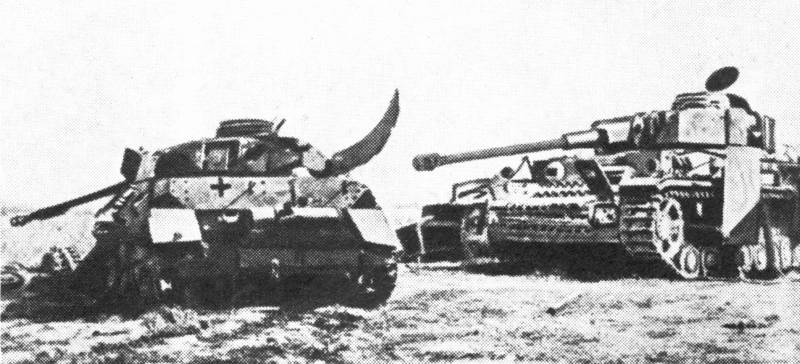
To be continued ...
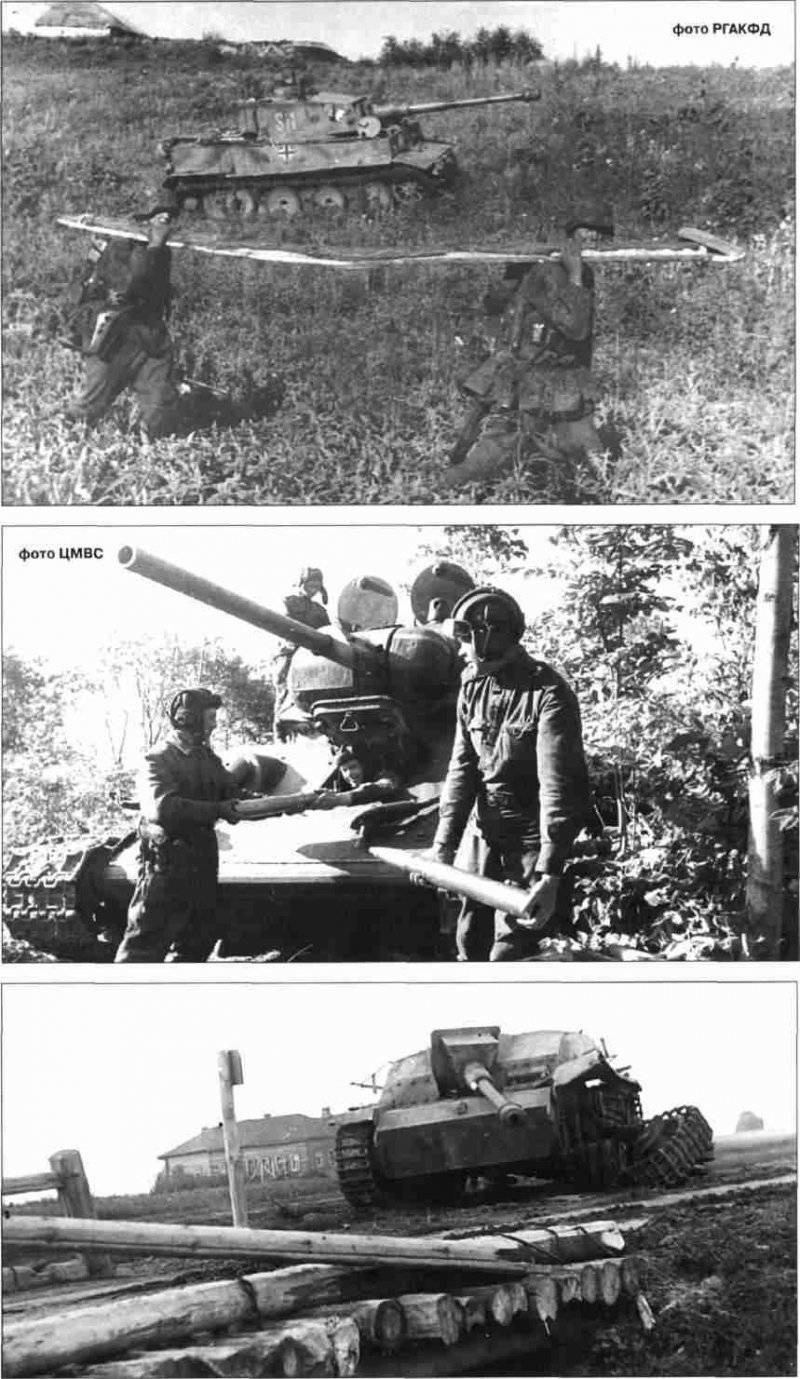
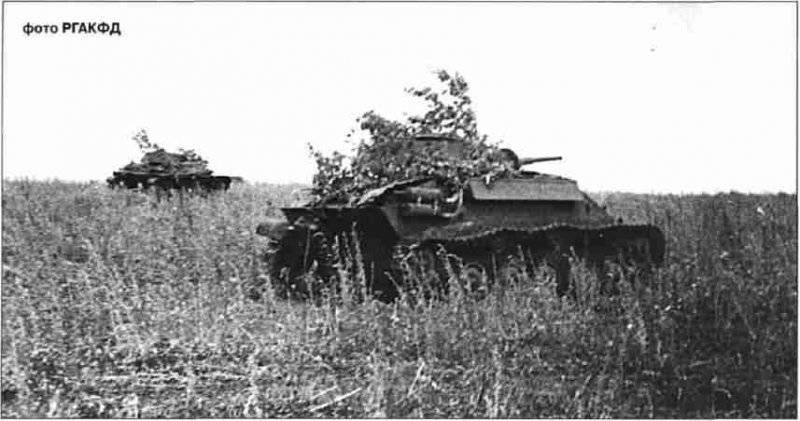
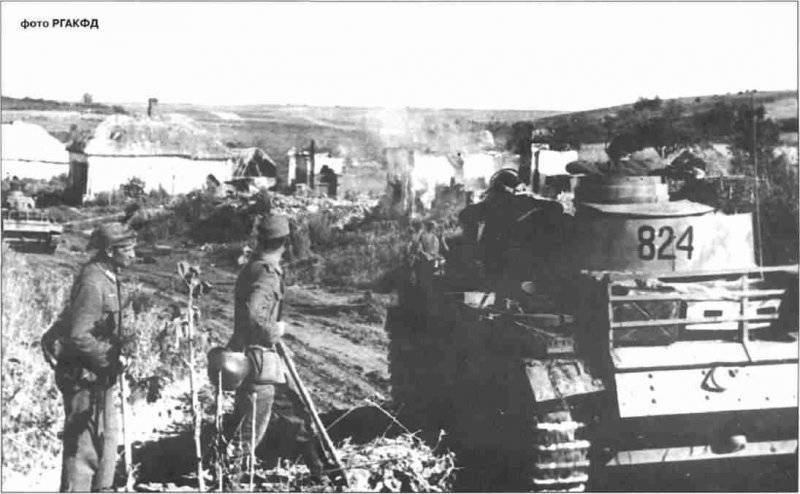
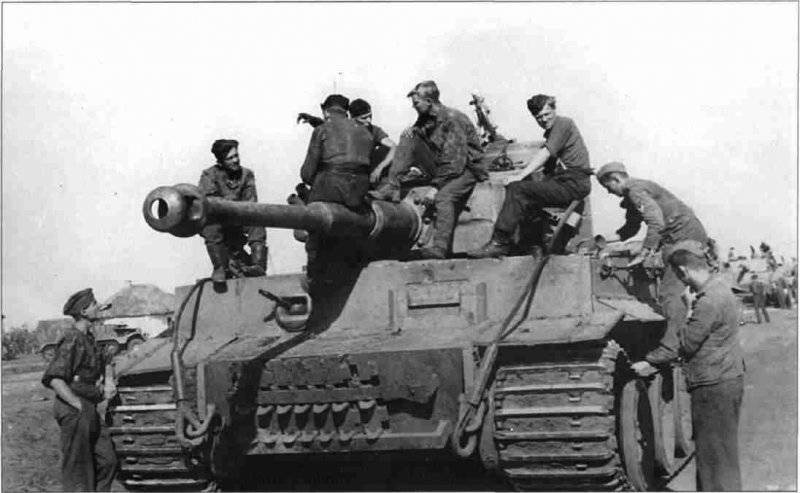
Information